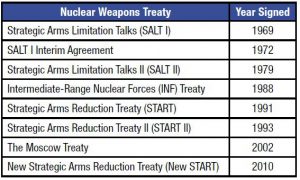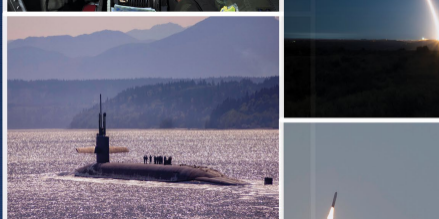This is a pivotal year in the life of the New START Treaty, as 2020 marks the tenth and final year of the treaty, in which the United States and Russia may agree to extend the treaty for a period of no more than five years. If allowed to expire it will remove all limits on the number of deployed as well as non-deployed strategic weapons and delivery systems that both sides can have.
Entered into force on February 5, 2011, during the Obama Administration, the New Strategic Arms Reduction Treaty (START) (formally known as the Treaty between the United States of America and the Russian Federation for the Further Reduction and Limitation of Strategic Offensive Arms) succeeded the previously negotiated Moscow Treaty (formally known as the Treaty between the United States of America and the Russian Federation on Strategic Offensive Reductions) [1]. The Moscow Treaty was finalized during the George W. Bush Administration and signed in 2002.
At the time of this publication, Russia has said that it is prepared to sign on to the five-year extension without preconditions [2]. The United States has not made a similar statement regarding a decision on whether to seek an extension [3]. In recent remarks, President Trump stated that he was considering replacing the bilateral discussions to renew or replace the New START Treaty with a trilateral discussion that would engage China, Russia, and the United States in nuclear arms reduction talks [3, 4]. With less than a year until the New START Treaty is set to expire unless extended or superseded by a new agreement, now is a good time to better understand the New START Treaty.
This article takes a look at what the New START Treaty is, the limits it places on strategic weapons and delivery vehicles and discusses potential consequences if the treaty is not extended.
What is the Old START Treaty?
Discussing the New START Treaty must begin by answering, “What is the Old START Treaty?” From the late 1960s and continuing to the present day, the United States has negotiated a number of bi-lateral agreements and treaties with Russia, and the Soviet Union previously, to limit the number of strategic nuclear weapons and reduce the risk of their inadvertent use. Each succeeding treaty reduced the number of deployed nuclear weapons. For the United States, the number is down more than 85 percent from its Cold War high [5]. Table 1 lists the treaties that the United States and the Soviet Union/Russia have negotiated and signed over the past 50 years to reduce the number of strategic nuclear weapons [6].

Table 1: Negotiated Treaties between the United States and the Soviet Union/Russia
It’s important to note the distinction between a treaty being signed and a treaty being ratified. A treaty is signed, following its negotiation, by the leaders of the countries, typically in a public signing ceremony. And a treaty is ratified, following its signing, by the legislatures of the countries. Only after ratification does the treaty enter into force, which then requires the countries to meet their treaty obligations.
Negotiations for the “old” START Treaty began in the early 1980s, during the Reagan Administration, and concluded in 1991, during the George H.W. Bush Administration, with the signing of the Treaty at Moscow on July 31, 1991. Later that year the Soviet Union collapsed, formally ceasing to exist on December 26, 1991, and the republics that made up the Soviet Union declared their independence. Russia was now one of four countries from the former Soviet Union possessing strategic nuclear weapons. The other three were Ukraine, Kazakhstan, and Belarus. In the Spring of 1992, those four nations and the United States negotiated a protocol to the START Treaty that “recognized Russia as the successor state to the Soviet Union’s nuclear rights and obligations [7],” which resulted in the return of all of the former Soviet Union’s weapons and delivery systems to Russia.
Article II of the START Treaty limited both sides to no more than 6,000 total warheads within seven years of entry into force. This figure of 6,000 total warheads was counted as individual warheads loaded on various delivery platforms: deployed intercontinental ballistic missiles (ICBMs), submarine-launched ballistic missiles (SLBMs), deployed ICBMs on mobile launchers (note: the Soviet Union had mobile launchers, the United States did not), and deployed heavy bombers [8].
The START Treaty was set to expire in 2009, but before then the two countries negotiated, signed, and ratified a new treaty. Known informally as the Treaty of Moscow, and officially as the Treaty Between the United States of America and the Russian Federation on Strategic Offensive Reductions (SORT)), it entered into force on June 1, 2003. It limited both sides to no more than 2,200 operationally deployed warheads. Although set to expire in 2012, it would be replaced New START in 2011.
How Many Weapons Can Each Nation Have Under the New START Treaty?
Surprisingly, the answer to how many weapons does each side have under the treaty is, “It depends!” Although the New START Treaty limits both sides to 1,550 strategic nuclear weapons, to be achieved within seven years of entry into force, determining what counts as a strategic nuclear weapon may lead to a number greater than 1,550, yet not violate the treaty.
Under the New START Treaty, total warheads are counted differently than they were in previous treaties, specifically regarding heavy bombers. Rather than continuing to count unique individual strategic nuclear weapons that can be delivered via heavy bombers, the New START treaty actually counts the number of heavy bombers in its total warhead count, regardless of how many warheads the heavy bombers can deliver. For example, if the United States has 20 heavy bombers capable of carrying 40 nuclear weapons, the total number of weapons counted against the Treaty limit is 20, and not 40. Article III of the Treaty states, “[F]or the purposes of counting toward the aggregate limit provided for… in this Treaty: … One nuclear warhead shall be counted for each deployed heavy bomber [9].” However, the same unique counting does not happen with ICBMs and SLBMs. For example, if an ICBM or SLBM has eight warheads, the aggregate count towards the treaty limit is eight, not one. Thus, with the unique counting of weapons carried by heavy bombers, it is possible for either side to possess more than 1,550 strategic nuclear weapons, yet not be in violation of the treaty.
The New START Treaty allows for 1,550 warheads spread among no more than 700 deployed ICBMs, deployed SLBMs, and deployed heavy bombers, and among no more than 800 total deployed and non-deployed ICBM launchers, SLBM launchers, and heavy bombers. [8] As of 1 September 2019, the United States counted 668 ICBMs, SLBMs, and heavy bombers as deployed, with 1,376 total warheads [10].
What Happens if Both Sides Do Nothing?
If the United States and Russia allow the New START Treaty to expire it will remove the current limits on the number of deployed and non-deployed strategic weapons and delivery systems. However, it is unlikely this would lead to a new arms race that sees both sides increase their arsenals to Cold War highs of tens of thousands of weapons. It is unlikely that the United States arsenal would increase. The Department of Defense’s 2018 Nuclear Posture Review (NPR) assessed that even in an evolving and uncertain international security environment, the United States reaffirmed a commitment to “the ultimate global elimination of nuclear, biological, and chemical, weapons [4].” And more specifically, the NPR points out that the United States met its New START Treaty obligations ahead of the 2018 deadline, and it doesn’t call out for increasing the number of nuclear weapons or delivery systems during the modernization efforts of the nuclear enterprise.
Currently, both sides are able to conduct up to 18 on-site verification inspections annually, something that would be halted if the treaty is not extended. Although there are benefits to on-site inspections if the treaty is extended, both countries certainly have national technical means to aid in gathering intelligence and determining nuclear activities to varying degrees of thoroughness. However, what would be lost without on-site inspections is the face-to-face interactions between Russian and American officials, which contribute to building of successful, positive long-term relations between the two countries.
If New START is not extended it will not be the first time that the United States and Russia have gone without a ratified treaty to obligate limits on their strategic nuclear weapons. For example, in 1979 the countries signed the second Strategic Arms Limitation Talks (SALT II) Treaty, but the treaty was not ratified, and thus it did not enter into force. However, both countries followed the terms of SALT II well into the next decade. It was during the 1980s when the countries held negotiations for the first START Treaty, which was signed in 1991.
Conclusion
Clearly, it is better to have arms control treaties between the two countries with the largest nuclear warhead stockpile than it is to not have such agreements. Beginning with the SALT I Treaty, negotiated in 1969 during the Nixon Administration, the two countries have always sought negotiations to put limits on their nuclear arsenals. The trend has always been further reductions in deployed weapons on both sides with each succeeding treaty. With or without an extension, if the result is that New START is replaced by a treaty that further reduces nuclear weapon stockpiles of the United States and Russia, that will be the outcome welcomed by the international community.
References
- The official New START website for the United States can be found at the following United States Department of State website: https://www.state.gov/new-start/
- Brennan, David. “America is risking a nuclear ‘free-for-all’ by delaying New START extension with Russia: Former National Security Official.” Newsweek, accessed at https://www.newsweek.com/america-risking-nuclear-free-all-delaying-new-start-extension-russia-national-security-official-1482542, on January 22, 2020.
- Pifer, Steven. “Trumps Bid to Go Big on Nuclear Arms Looks Like a Fizzle.” Defense One, accessed at https://www.defenseone.com/ideas/2020/02/trumps-bid-go-big-nuclear-arms-looks-fizzle/162914/, on February 5, 2020.
- Oronez, Franco. “Trump’s Push for Lofty Nuclear Treaty Sparks Worry over Current Deal.” NPR, accessed at https://www.npr.org/2020/01/01/792725906/trumps-push-for-lofty-nuclear-treaty-sparks-worry-over-current-deal, on January 17, 2020.
- 2018 Nuclear Posture Review. (February 2018). Washington, DC: Department of Defense.
- Treaties of the United States can be found on the Department of State’s Bureau of Arms Control, Verification, and Compliance website at: https://www.state.gov/key-topics-bureau-of-arms-control-verification-and-compliance/
- Reed, Thomas C. and Stillman, Danny B. (2009). The Nuclear Express: A Political History of the Bomb and its Proliferation. Minneapolis, MN: Zenith Press.
- Treaty Between the United States of America and the Union of Soviet Socialist Republics on the Reduction and Limitation of Strategic Offensive Arms, U.S. Government Printing Office: 1991.
- The full text of the New START Treaty can be found at the Department of State website at: https://2009-2017.state.gov/documents/organization/140035.pdf
- Fact Sheet, New START Treaty Aggregate Numbers of Strategic Offensive Arms, January 1, 2020; Bureau of Arms Control, Verification, and Compliance, United States Department of State, accessed at https://www.state.gov/wp-content/uploads/2019/12/AVC-New-START-Jan-2020.pdf, on January 2, 2020.


